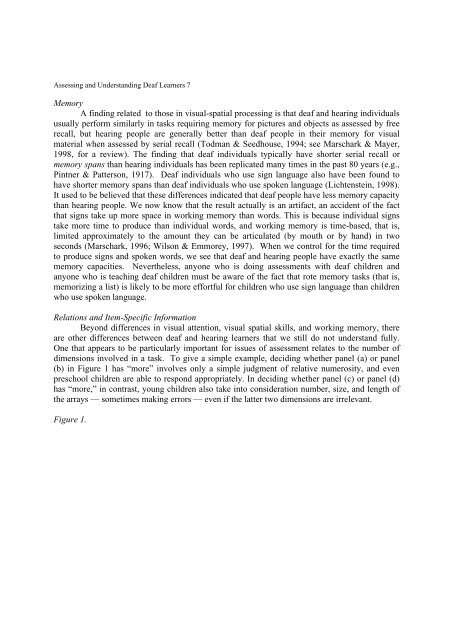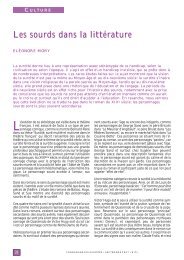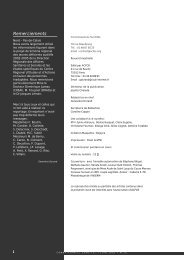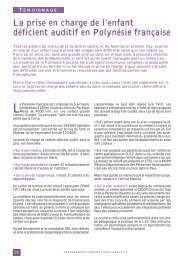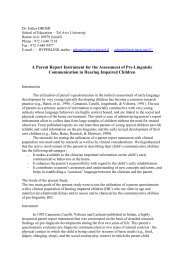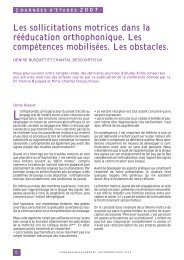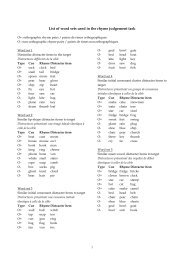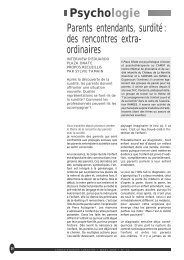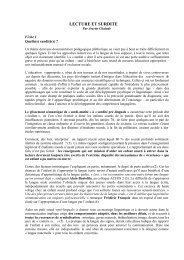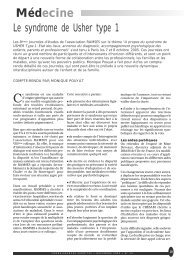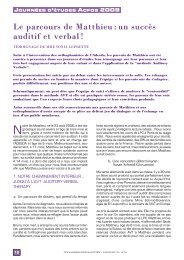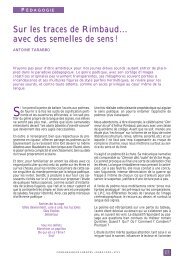<strong>Assessing</strong> <strong>and</strong> Underst<strong>and</strong>ing <strong>Deaf</strong> <strong>Learners</strong> 6Osberger, Mitchell, & Katz, 1994). Quittner et al. (1994) showed quite clearly that residualhearing <strong>and</strong> use of hearing aids can support visual attention in children 6-8 years old. For olderchildren, 9-13 years old, cochlear implants were found to be even better.Note that the issue here is not about a link between cochlear implants <strong>and</strong> language, atleast not directly. The point is that auditory information supports visual attention <strong>and</strong> thus socialinteraction <strong>and</strong> learning in general. Specifically, young children’s experience in “triangulating”between an object, adults who identify or label things in the environment, <strong>and</strong> themselvesappears to play an important part in the development of visual attention <strong>and</strong>, probably, in earlyvocabulary (Spencer, 2000). The ability to make use of auditory cues is not an essential factor ineither of these, but it clearly is a supporting factor.Visual-SpatialProcessingGiven that deaf children’s learning depends primarily on visual information, it isimportant to recognize differences between them <strong>and</strong> their hearing age-mates — in bothdirections — in the domain of visual-spatial processing. <strong>Deaf</strong> individuals, for example, tend tobe faster than hearing individuals in redirecting visual attention from one spatial location toanother (Parasnis & Samar, 1985) <strong>and</strong> in their ability to detect motion in the periphery,especially when that if motion is language-relevant (Swisher, 1993). They also have anadvantage in their perception <strong>and</strong> memory for complex visual signs, in face discrimination(Bettger, Emmorey, McCullough, & Bellugi, 1997), <strong>and</strong> in the ability to generate <strong>and</strong> eithertransform or rotate mental images (Emmorey, 1998).The extensive literature on the generation <strong>and</strong> manipulation of mental images may beunfamiliar to many educators, so let me explain briefly. Imagine that you are st<strong>and</strong>ing in front ofthe Eiffel Tower looking toward it. When you have a good visual image of it, make the towerrise off the ground <strong>and</strong> rotate its base away from you, so that the television antenna on the topcomes down to point directly at you. Not everyone can do this kind of generation <strong>and</strong> rotation,but most people can with some degree of clarity. Assuming that you were able to do so, what doyou see? It should look like something approximating a large letter “X,” <strong>and</strong> there is no otherway to discern the result other than “visually.” The chances are that if you are deaf, this task waseasier (or faster) for you than if you are hearing. This does not mean that deaf people areuniformly better than hearing people in visual imagery. But exposure to sign language appears toresult in a neuropsychological organization that has advantages in some domains (Bettger et al.,1997; Emmorey, 1998), <strong>and</strong> this is one of them.The same holds for face recognition. Bettger et al. (1997) showed that adults <strong>and</strong>children who were native users of sign language showed enhanced ability to discriminate <strong>and</strong>recognize novel faces relative to hearing peers. The two groups were essentially equivalent,however, in their ability to recognize faces that were seen in a rotated position, indicating thatthere is something special about faces (in their canonical form) for people who depend on themfor grammatical information. So this is not just a general advantage held by deaf individuals. Itrequires a specific kind of experience — one that most hearing people do not have. In fact, suchfindings appear only to hold for people raised using sign language. These limitations indicatethat the differences observed between deaf <strong>and</strong> hearing individuals do not reflect any simplesensory compensation as a result of hearing loss (Bettger et al., 1997; Parasnis, Samar, Bettger,& Sathe, 1996). The causes <strong>and</strong> effects of such differences are much more specific.
<strong>Assessing</strong> <strong>and</strong> Underst<strong>and</strong>ing <strong>Deaf</strong> <strong>Learners</strong> 7MemoryA finding related to those in visual-spatial processing is that deaf <strong>and</strong> hearing individualsusually perform similarly in tasks requiring memory for pictures <strong>and</strong> objects as assessed by freerecall, but hearing people are generally better than deaf people in their memory for visualmaterial when assessed by serial recall (Todman & Seedhouse, 1994; see Marschark & Mayer,1998, for a review). The finding that deaf individuals typically have shorter serial recall ormemory spans than hearing individuals has been replicated many times in the past 80 years (e.g.,Pintner & Patterson, 1917). <strong>Deaf</strong> individuals who use sign language also have been found tohave shorter memory spans than deaf individuals who use spoken language (Lichtenstein, 1998).It used to be believed that these differences indicated that deaf people have less memory capacitythan hearing people. We now know that the result actually is an artifact, an accident of the factthat signs take up more space in working memory than words. This is because individual signstake more time to produce than individual words, <strong>and</strong> working memory is time-based, that is,limited approximately to the amount they can be articulated (by mouth or by h<strong>and</strong>) in twoseconds (Marschark, 1996; Wilson & Emmorey, 1997). When we control for the time requiredto produce signs <strong>and</strong> spoken words, we see that deaf <strong>and</strong> hearing people have exactly the samememory capacities. Nevertheless, anyone who is doing assessments with deaf children <strong>and</strong>anyone who is teaching deaf children must be aware of the fact that rote memory tasks (that is,memorizing a list) is likely to be more effortful for children who use sign language than childrenwho use spoken language.Relations <strong>and</strong> Item-Specific InformationBeyond differences in visual attention, visual spatial skills, <strong>and</strong> working memory, thereare other differences between deaf <strong>and</strong> hearing learners that we still do not underst<strong>and</strong> fully.One that appears to be particularly important for issues of assessment relates to the number ofdimensions involved in a task. To give a simple example, deciding whether panel (a) or panel(b) in Figure 1 has “more” involves only a simple judgment of relative numerosity, <strong>and</strong> evenpreschool children are able to respond appropriately. In deciding whether panel (c) or panel (d)has “more,” in contrast, young children also take into consideration number, size, <strong>and</strong> length ofthe arrays — sometimes making errors — even if the latter two dimensions are irrelevant.Figure 1.


